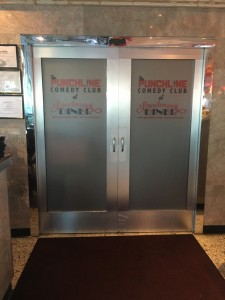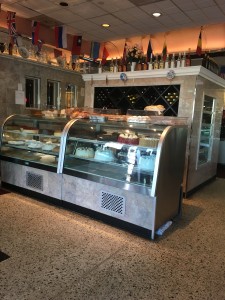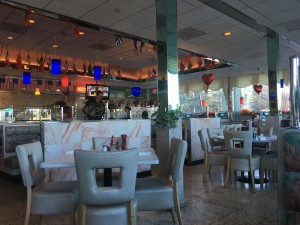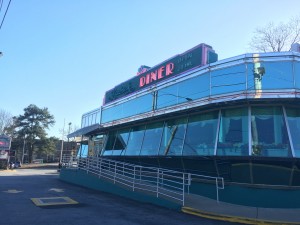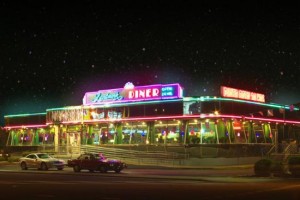 In the late 1960’s, Tom Lambrou founder of Landmark Diner was a Greek immigrant who started of working as a cook on ships that traveled all around Europe, Africa, and even Asia. When Lambrou arrived in America, he was reduced into working low-leveled position such as dishwasher or busboy. But by the age of 23, Tom Lambrou had saved up enough money and experience to open up several diners in New York. In 1994, Lambrou made the big decision to move to Atlanta and open up his first diner in Buckhead, the first Landmark Diner. His incentive for this major move was that at the time Atlanta was a rapidly growing city and plus the Olympics were on its way. Over the next several years, Tom Lambrou collected the rewards from his hard work and was able to open 4 more Landmark Diner location around Atlanta. The Landmark Diner in Buckhead is the original 24 hour diner located in the heart of Buckhead, at the corner of Peidmont and Roswell road. The Landmark Diner is a traditional New York operated diner with a large menu with breakfast, lunch and dinner served all day. The menu ranges from your simple steak gyro to fresh seafood, along with your typical diner foods. The building of the Landmark diner itself is reminiscent of a old school 50’s diner; with metallic reflective exterior walls, large paneled windows, and neon lights around the building/signs. Despite the diner having being built in 1994 is a little run down and old, it still doesn’t take away the authenticity and inviting manner of the restaurant itself. Upon entering the diner, you are greeted with a bakery case filled with homemade cakes, pies, breads, and other pastries. On the left of the restaurant is the Punchline Comedy Club, a side lounge that is apart of the diner that shows live comedy and music from Wednesday night and continues until Saturday night. The interior design of the diner is quit unique from any other diner in Atlanta. The floors and walls plus the bar near the back of the diner are made up of all marble. Booths and tables crowd up the floor, leaving just enough room for people and servers to walk around. Big white cream colored drapes hang from the window and fake potted flower beds sit on the window sills. The ceiling is decorated with different hanging international flags along with bottles of alcohol aligned on shelfs around the bar. On my visit to the Landmark Diner in Buckhead, the servers are friendly and are willing to hold a conversation with you, especially if you were a regular; which they get a lot of since most of the employee remember the customers names coming in. So whether your a person who is looking for quick bite after a late night of being out or just a regular customer looking for some delicious homemade diner food with the accompany of a familiar face; the Landmark Diner in Buckhead is Altanta’s Premier 24 hour diner that provides your favorite meals with a dedicated staff that is devoted on making your experince the best around.
In the late 1960’s, Tom Lambrou founder of Landmark Diner was a Greek immigrant who started of working as a cook on ships that traveled all around Europe, Africa, and even Asia. When Lambrou arrived in America, he was reduced into working low-leveled position such as dishwasher or busboy. But by the age of 23, Tom Lambrou had saved up enough money and experience to open up several diners in New York. In 1994, Lambrou made the big decision to move to Atlanta and open up his first diner in Buckhead, the first Landmark Diner. His incentive for this major move was that at the time Atlanta was a rapidly growing city and plus the Olympics were on its way. Over the next several years, Tom Lambrou collected the rewards from his hard work and was able to open 4 more Landmark Diner location around Atlanta. The Landmark Diner in Buckhead is the original 24 hour diner located in the heart of Buckhead, at the corner of Peidmont and Roswell road. The Landmark Diner is a traditional New York operated diner with a large menu with breakfast, lunch and dinner served all day. The menu ranges from your simple steak gyro to fresh seafood, along with your typical diner foods. The building of the Landmark diner itself is reminiscent of a old school 50’s diner; with metallic reflective exterior walls, large paneled windows, and neon lights around the building/signs. Despite the diner having being built in 1994 is a little run down and old, it still doesn’t take away the authenticity and inviting manner of the restaurant itself. Upon entering the diner, you are greeted with a bakery case filled with homemade cakes, pies, breads, and other pastries. On the left of the restaurant is the Punchline Comedy Club, a side lounge that is apart of the diner that shows live comedy and music from Wednesday night and continues until Saturday night. The interior design of the diner is quit unique from any other diner in Atlanta. The floors and walls plus the bar near the back of the diner are made up of all marble. Booths and tables crowd up the floor, leaving just enough room for people and servers to walk around. Big white cream colored drapes hang from the window and fake potted flower beds sit on the window sills. The ceiling is decorated with different hanging international flags along with bottles of alcohol aligned on shelfs around the bar. On my visit to the Landmark Diner in Buckhead, the servers are friendly and are willing to hold a conversation with you, especially if you were a regular; which they get a lot of since most of the employee remember the customers names coming in. So whether your a person who is looking for quick bite after a late night of being out or just a regular customer looking for some delicious homemade diner food with the accompany of a familiar face; the Landmark Diner in Buckhead is Altanta’s Premier 24 hour diner that provides your favorite meals with a dedicated staff that is devoted on making your experince the best around.
Tag Archives: Unit 2
Interior Built Environment: Digital Record 6
On left of the diner are the double doors that lead to the Punchline Comedy Club. This is a side lounge connected to the diner and provides live comedy and music nightly. Unfortunately I didn’t have the chance to enter the lounge while I was at the diner, since it was too early at the time for a show.
Interior Built Environment: Digital Record 5
Upon entering the diner, you are greeted with a glass bakery case filled with an assortment of homemade cakes and pies. On top of the case were baked breads and other pastries that you could smell when walking through the doors of the diner. Behind the bakery case, different kinds of bottled alcohol are on display in and on top of shelves. This was the most inviting aspect to the diner to me, since almost everyone loves sweets and you could see that they make their own food from scratch.
Interior Built Environment: Digital Record 4
The all marble bar provides for costumers looking for a quick bite. Behind the bar, the setup looks like any typical diner with dishes/glasses, soda dispenser, coffee maker, and bottles of alcohol; all up front enabling quick and easy access for the server. T.Vs were setup on both ends of the bar, so customers could catch up with the news while they ate. Personally, having previously ate at the diner, I would have prefer to eat at the bar since it is quick and the servers were nice enough to hold up conversations with you while you sat there.
Interior Built Environment: Digital Record 3
During the day, the huge paneled windows bring in a lot of natural light exposing the unique interior design of the diner. The floors and walls are all made of marble which provide a elegant touch to the place. International flags are hung all around the ceiling of the diner. All these aspects can be seen when entering the diner were you have a choice of enjoy you meal on the tables, booths, or at the bar.
Interior Built Environment: Digital Record 2
The Landmark Diner itself is beautifully designed authentic diner. The panels that make up the diner are shiny and reflective almost like mirrors. Neon lights extended all around the diner and make up the letters on the signs. Through the big window panels you could see interior design of the diner with drapes and potted flower beds on the window sills. The combination of the unique architecture, interior design, and neon lights; I could imagine that this diner attracts many nighttime travelers for a good bite to eat after a long night out, especially since its a 24 hour diner.
Interior Built Environment: Digital Record 1
Annotated Bibliography 6
Cottrell, Megan. “Libraries Move Toward Gender-Neutral Bathrooms.” American Libraries46.11/12 (2015): 16-17. Consumer Health Complete – EBSCOhost. Web. 21 Feb. 2016.
In this article, Megan Cottrell describe how public libraries are making a move towards gend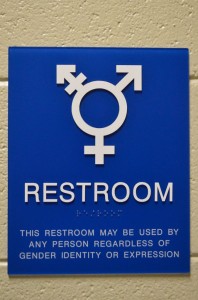 er-neutral bathrooms. Liberians everywhere work to ensure that their collection and programs offer members of their community a safe place, therefore some libraries today are including bathrooms that accommodate to the transgender or the gender nonconforming. Surveys show that transgender people often experience discrimination in restrooms, such as being stared at, ridiculed, told to leave, or not allowed to use the facilities; even physical violence or having the police called. The article gives an example of Portland Community College, Oregon’s largest post-secondary institution, who has taken on the issues of gender-neutral restrooms and has received a lot of positive feedback; both from the transgender community as well as other students who appreciate the privacy of 22 new all-gender bathrooms. While this is an issue for libraries building new spaces, others are figuring out ways to make patrons comfortable with their existing facilities, which also raises many different issues. Overall as society moves towards a more transgender accepting society, libraries need to serve those particular patron, have a safe place that welcomes them without judgment.
er-neutral bathrooms. Liberians everywhere work to ensure that their collection and programs offer members of their community a safe place, therefore some libraries today are including bathrooms that accommodate to the transgender or the gender nonconforming. Surveys show that transgender people often experience discrimination in restrooms, such as being stared at, ridiculed, told to leave, or not allowed to use the facilities; even physical violence or having the police called. The article gives an example of Portland Community College, Oregon’s largest post-secondary institution, who has taken on the issues of gender-neutral restrooms and has received a lot of positive feedback; both from the transgender community as well as other students who appreciate the privacy of 22 new all-gender bathrooms. While this is an issue for libraries building new spaces, others are figuring out ways to make patrons comfortable with their existing facilities, which also raises many different issues. Overall as society moves towards a more transgender accepting society, libraries need to serve those particular patron, have a safe place that welcomes them without judgment.
I chose this source because it further discusses gender-neutral bathrooms in a specific place, libraries. A flaw in this essay is that it provides a solution and evidence to gender-neutral bathrooms but only account for bathrooms in school libraries.
Annotated Bibliography 5
Felsenthal, Kim D. “Creating The Queendom: A Lens On Transy House.” Home Cultures 6.3 (2009): 243-260. Art & Architecture Complete. Web. 21 Feb. 2016.
 In this study, Kim D. Felsenthal explores the unique landscape of Transy Houses (transcape) and the person and place interaction within them. Transy houses is a trans-dominated communal house where residents control a defined socio-spatial territory. In her research, Felsenthal raises the issue on how there is little space in physical geography where trans persons can safely be who they are without fear of homophobic or transphobic violence. She explains how a transgender home is a place were they self identify and serve as multifunctional platform for everyday common use. The study shows how there are unique differences in each room of a Transy House, each having their own design and furnishing specific to that individual. In shared areas, you can see a collective identity is formed when attributes of one’s own characteristics and self-identification merge with that of the larger group with which one is associated. Kim Felsenthal explains how transcape provide the gay, lesbian, bisexual, transgender, queer/questioning (GLBTQ) communities; a private place where they are empowered to make their own trans-normative rules for behavior and gender expression. Additionally, occupants have opportunities to manipulate the physical environment to exhibit and fortify their trans identities away from norms and values of mainstream society.
In this study, Kim D. Felsenthal explores the unique landscape of Transy Houses (transcape) and the person and place interaction within them. Transy houses is a trans-dominated communal house where residents control a defined socio-spatial territory. In her research, Felsenthal raises the issue on how there is little space in physical geography where trans persons can safely be who they are without fear of homophobic or transphobic violence. She explains how a transgender home is a place were they self identify and serve as multifunctional platform for everyday common use. The study shows how there are unique differences in each room of a Transy House, each having their own design and furnishing specific to that individual. In shared areas, you can see a collective identity is formed when attributes of one’s own characteristics and self-identification merge with that of the larger group with which one is associated. Kim Felsenthal explains how transcape provide the gay, lesbian, bisexual, transgender, queer/questioning (GLBTQ) communities; a private place where they are empowered to make their own trans-normative rules for behavior and gender expression. Additionally, occupants have opportunities to manipulate the physical environment to exhibit and fortify their trans identities away from norms and values of mainstream society.
I chose this source because it explores and gives more of a understanding to the LGBT community.
Annotated Bibliography 4
Pickerill, Jenny. “Who Builds The Houses?.” Communities 162 (2014): 20. Advanced Placement Source. Web. 21 Feb. 2016.
In Jenny Pickerill’s article, she studies men and women involvement in the building of eco-communities and the struggle to overcome gender inequality. Pickerill explains how she has been researching and working with eco-communities for the last decade, in her studies she focuses on how houses in eco-communities get built, the decisions, choices, and dilemmas involved, the costs, the compromises, and how the completed house is lived in, works, and functions. Despite the feminist movement in the last century, eco-communities still experience gender inequality when it comes to building and living. Throughout her travels, Pickerill explains how females in general are socially stereotyped to primarily have and raise a family, in doing so they are expected to spend their time doing domestic chores. Pickerill then translates this into female eco-builders who are viewed as being weaker than men therefore they cannot be good builders. She rebuttals this by stating that building doesn’t require strength alone but creativity and communication; things men and women can do. Jenny Pickerrill concludes her argument by stating that we need to embrace gender as a form of diversity, but not as a division of labor. We need to create space for women to build and to acknowledge the work that many women already do on build sites. To women’s contributions visible and valued.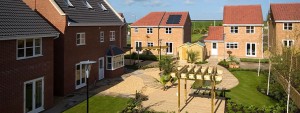
I chose this source because it relates to the topic of this unit on gender equality. This source can be compared to the issues brought up in LGBT equality.
